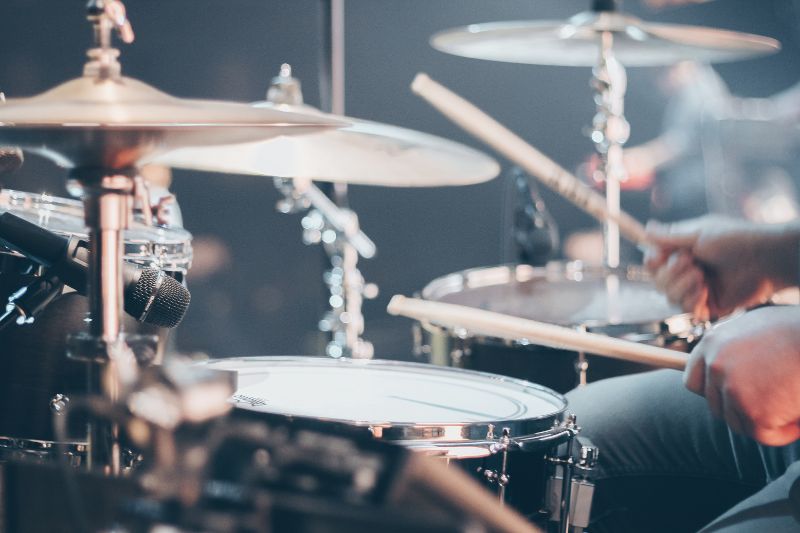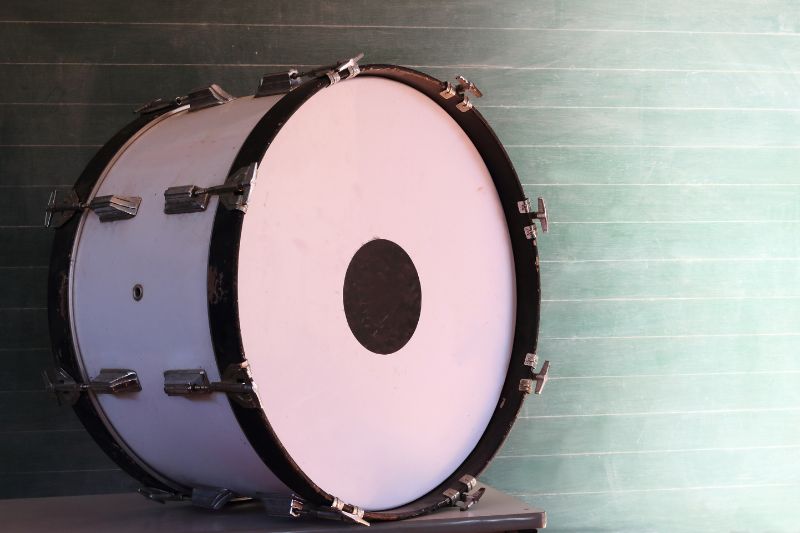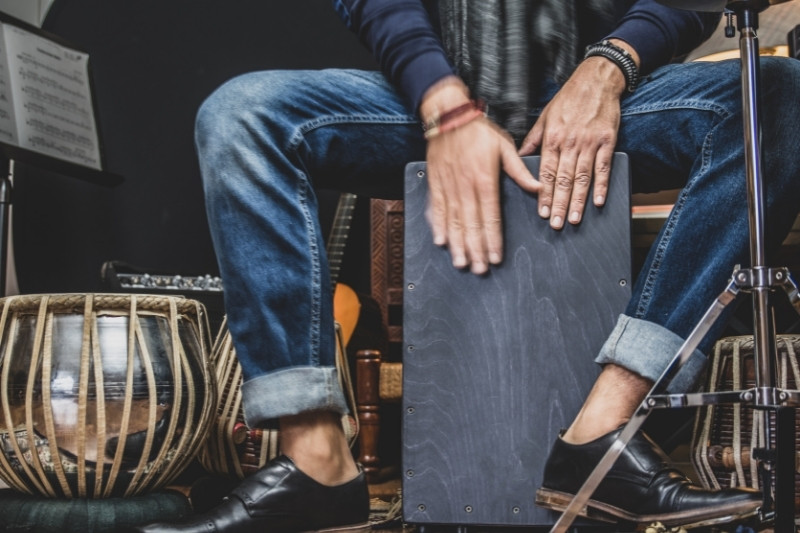A Beginner’s Guide to Marching Drums and Percussion
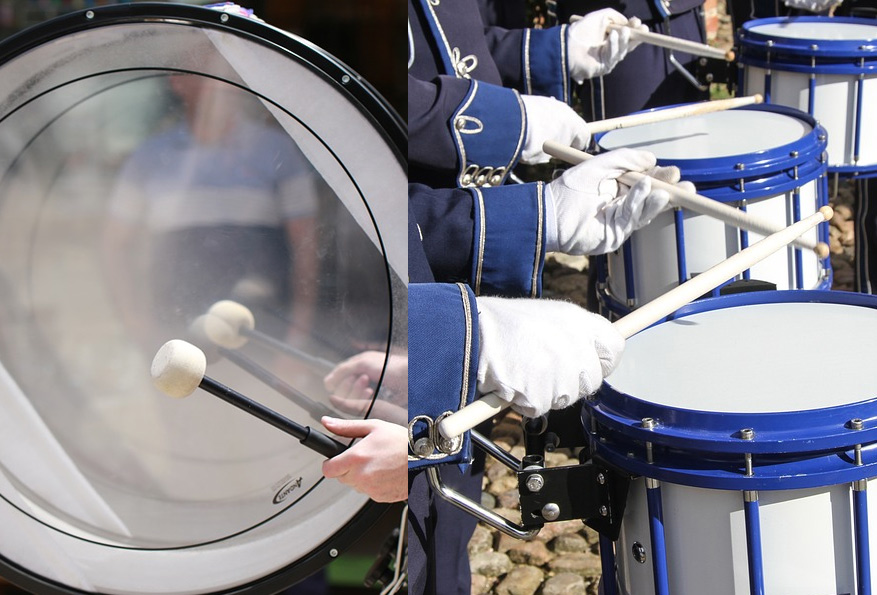
This is your ultimate guide to marching drums. We’re going to talk about each of the main drums (snare, bass, tenor), marching cymbals, drum carriers, and drumsticks.
Marching drums are specially designed for the needs of marching or moving drumlines and coupled with a harness or carrier/rack that is worn by the players. They are usually played outdoors in a marching band or corps (drum corps or bugle corps). The percussion ensemble of the corps is called a battery or drumline.
The drumline is the moving or marching part of the band that can also include a pit. The pit is an optional stationary section that contains melodic instruments like the glockenspiel and concert percussion.
Marching drums generally have more depth or design modifications added to extract the maximum projection and volume from the instrument. Their tuning is also done in a way that exaggerates the loudness and articulation of the drum.
A well-balanced drumline often consists of 4 to 8 snare drums, 2 to 4 tenor drums, and a minimum of 5 bass drum players.
The instrument size is determined by the skill level and the role you play in the drumline.
Brand and budget will also play a role in the final decision and the quality of sound. Yamaha, Pearl, Ludwig, Tama, and Zildjian are some well-known brands that manufacture high-quality marching drums and hardware.
In the following sections, we go through all the individual components of a drumline in detail and provide some noteworthy drum, hardware, and accessory recommendations.
Contents
Marching Snare Drums
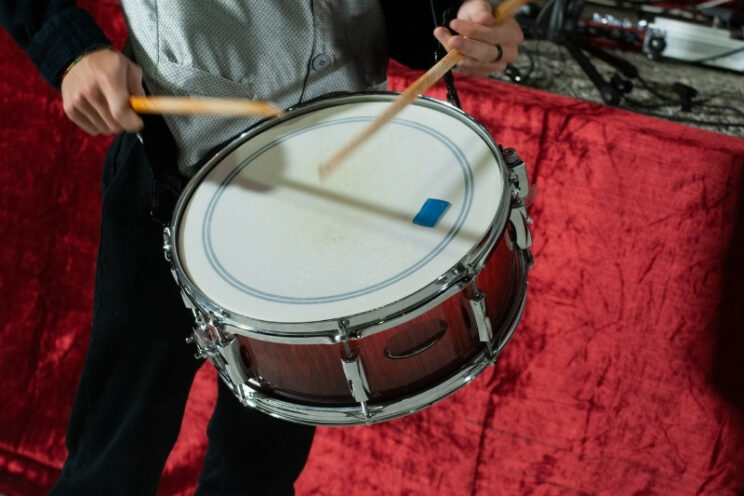
The marching snare drums are the loudest and most flamboyant part of the marching band as they stroll through a parade. They look and sound very different from the usual snare that you see in a drum set and are not interchangeable. Marching snare drums often have a similar width to a snare on a drum set but the depth can be more than twice the size.
This gives the instrument better projection and a bigger, fuller, and louder sound that is necessary for their outdoor use. The 14×12 inch size is the most commonly used but the smaller (piccolo) snares and high-tension snares have gained a lot of popularity in the past decade.
The common accessories required are a snare drum carrier and/or a snare drum sling, drumsticks, and drum heads. The snare head varies based on the style of the drumline and plays an important role in volume and stick articulation. Kevlar-fiber is preferred for the bottom due to its durability in high-tension snares, and Aramid-fiber heads are very popular for their tone and projection.
Snare Drum Carriers
The Pearl MX T-Frame Snare drum carrier and Yamaha Power-Lite Carrier are highly adjustable options that offer superior comfort.
Snare Drumsticks
As for drumsticks, the Vic Firth Ralph Hardimon, Colin McNutt Signature, and Corpsmaster MS5 are ideal for accommodating a wide range of skills and expertise.
Marching Bass drum

Marching bass drums are very different compared to the kick drum you find in a drum set. It plays a very important role in keeping the pulse in the drumline and there can be multiple bass drum players.
It would be unimaginably tiring to hold on to heavy bass drums used for stage performances in a long parade. The marching bass drum is significantly lighter to make it easy to tote. The bass drummers in the marching band or corps usually need to be pretty strong and need to develop the stamina required for this task.
The size of the drum varies between 14” to 36” and is determined by the stamina and strength of the bass drummer in the ensemble. Besides the weight, the other key difference is the bass drum head which is made from a PET film instead of the usual double or single coated heads.
Marching bass drums vary from 14” to 36 inches (51mm to 910mm) and are available in 8, 10, and 12 lug versions. They also require a strap and/or an adjustable formfitting shoulder-frame styled bass drum carrier to deliver an unencumbered performance
Marching Bass Drum Mallet – Recommendations:
Vic Firth Corpsmaster Marching Bass Mallets are a good option and they are available in every size and style. The Promark PSMB2, Promark M322 Large and Yamaha MBM-150 bass drum mallets are other noteworthy options. It would also be a good idea to invest in a marching bass drum mallet holder like the Yamaha MBMH2.
Tenor drum (or toms)
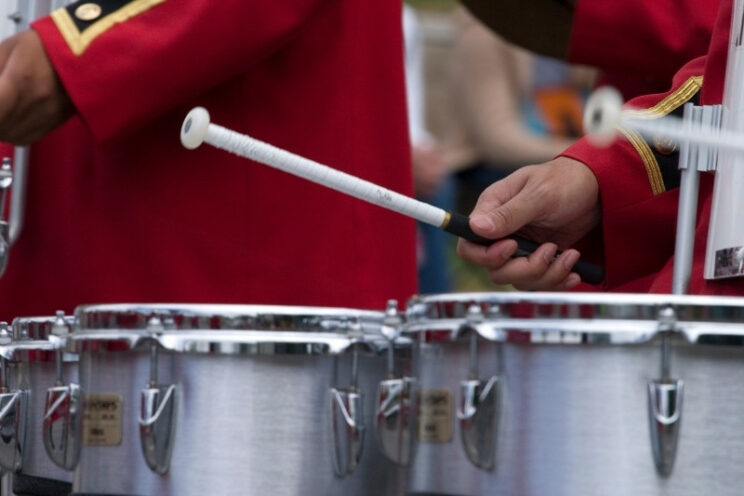
The number of tenor players depends on the number of snare drums in the drumline. The traditional ratio is 2:3 to create a balanced sound between the two instruments. For instance – if you have 6 snares, you will have 3 tenor players. The typical number in a drumline varies from 1 to 6, but 4 to 5 tenor players are considered to be ideal for modern drum corps.
A full tenor section contains four size drums (10, 12, 13 & 14”) in an arch with one or two ‘gocks’ (also called shot or spock) inside the arc. The gock is a smaller sized tenor drum – usually 6” or 8”. The four-drum configuration is called a quad. If you add one gock to the setup it becomes a quint, and if you add two it is called a sixpack.
Tenor drums are single-headed tom-toms that can either be played individually or in some cases, by a multi-tenor who plays several of them placed on a rack. They have a PET film double-ply top head with no bottom head for loud and forward-pointed projection. The playing technique is similar to timpani i.e. you play closer to the edge as opposed to the center.
Tenor drumsticks are made from wood or aluminum shafts with disc-shaped nylon heads.
For the sake of variety, many drummers use felt/fleece-headed mallets, drum brushes, and other implements to achieve certain stylistic timbres.
Tenor Drum Sticks – Recommendation:
The Vic Firth Corpsmaster Multi-Tenor Mallets Aluminum Shaft is a popular choice.
Marching Cymbals + leather straps
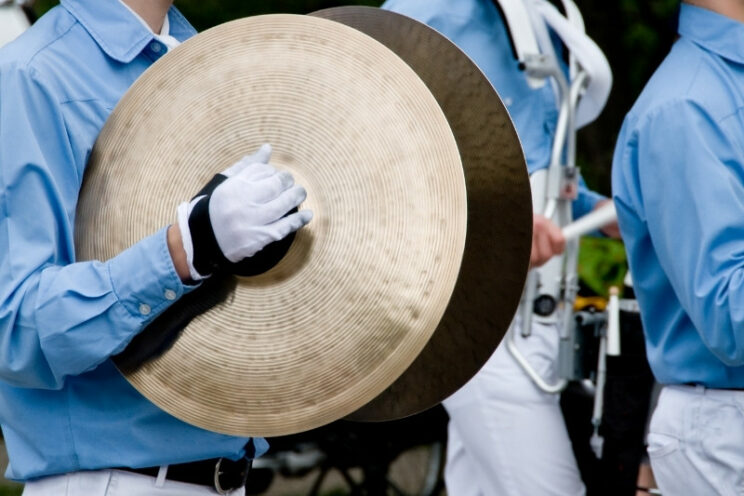
Cymbals provide an explosive burst of bold and bright sounds. They aren’t struck by a drumstick like you would with a traditional drum set. Instead, they are played by slapping them together with their hands (like a clap). You need to pair cymbals with hand straps.
These hand straps, usually made out of leather, are gripped by putting your hand through the hook and placing it against the bell of the cymbal. Besides the typical ‘crashing them together’ sound, various handgrips and rubbing motions are used to create a variety of sounds and effects.
Cymbals often include tracks such as flips, twirls, and other fancy maneuvers to please the crowd. A good cymbal has an emphatic ring that will reverberate clearly into every corner of the outdoor space.
Drum corps specialists prefer warm-sounding cymbals with ample high-end shimmer and projection. The medium-sized cymbals have bright overtones and a wide sonic spectrum. Cymbals and crash cymbals are available in different sizes and are sold as matched pairs, usually in bronze.
Marching Cymbal Hand Straps
As for hand straps, you can also opt for the Zildjian Russet Leather Cymbal Pads or Meinl Marching Cymbal Leather Straps – all of these are premium offerings that are durable and well-designed for rough usage.
Timpani
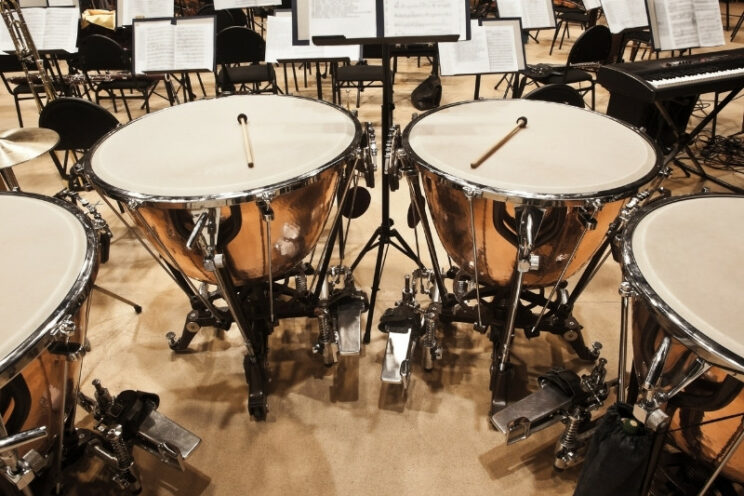
On occasion, you may find the use of modified timpanis being used in a traditional drum corps and big modern front ensembles. Timpanis need to be carried high on the body and don’t hold tuning especially if they are of poor quality.
They are sometimes supported by DIY wooden blocks placed between the instrument and player to make them more comfortable.
Since there are no specialized harnesses for the instrument, most timpani players use two regular snare slings and hook them to support it. or a trip-pod leg system for grounding the instrument.
Timpani are generally heavy instruments so marching with them can be a difficult job!
Tips For Marching Drums
You will also need to buy reliable cases to transport your instruments and to store them safely when they are not being used. A good drum cover can be used in rehearsals or for home practice to improve the life of the drum head and to maintain a low noise profile in indoor environments.
Always keep a toolbox with all the essential pieces of hardware that you need regularly. This can include screwdrivers, pliers, drum keys, spare foam, cleaning rags, and some duct tape. You should also have replacement heads on hand in case of an emergency.
Bass drum heads last well over a year but all other heads will need to be replaced between 8 to 12 months, depending on usage. Spend some time at regular intervals to inspect and maintain your instrument. Replace any hardware that has rust or is damaged and check for proper torque. Before you leave, check out this tuning-related printable PDF from D’addario that shares some easy-to-follow instructions on how to tune marching drums.
Summary
Marching drums and percussions are essential for drum corps, bands, and other related ensembles. This article covered the basic concepts of marching instruments so that it can help beginners understand them better. Also giving you some valuable tips on buying materials to make your purchase process easier!
Just like with any piece of hardware, care and maintenance are important components for keeping your instruments in top form. Be sure to stay on top of tuning and sizing changes, as well as stock up on parts like drum hardware, snare drum shells, cymbals, timpani heads, etc.
These are all very important details that you should consider when purchasing marching drums or even regular acoustic ones!





